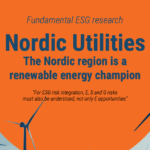ESG research and Nordic High Yield issuers – Status, ESG risks we see and how to Engage?
High Yield is a market segment where the ESG risk is high as the companies are overall weak in sustainability reporting and ESG risk mitigation.
ESG risks are likely to impact the performance of a company in the future. Therefore, it is part of the fiduciary duty and in EU it is mandatory to integrate ESG risks (sustainability risks) in actively managed investment products. This is related to SFDR article 6, that is not to forget among all the SFDR article 8 and 9 discussions.
sustainAX recently broke through the milestone of 200 ESG researched companies. Most of these companies are credit issuers, and many of them are High Yield issuers.
We see many areas where the investors should engage with the companies to help them reduce their ESG risk.
How we do ESG research of these companies at sustainAX?
We spend time to understand the perimeter of the companies, their real own activities, and what sector(s) they belong in, this will have an impact on the ESG risk materiality of the company. Where and what are the typical ESG risks? And how important are these?
We work with a double materiality perspective, that is, not only do we consider the impacts from the world on the company (outside-in), but we also consider the impacts the company has on the world around them (inside-out) that can boomerang back into the company as risks. The latter can happen when stakeholders react and change behaviour.
We research all published material by the company, annual reports sustainability reports, websites, etc. to find out what the company is doing to reduce or mitigate ESG risks. We also use external sources for controversy checks.
When we have finished our job, we have a professional idea of the residual or remaining ESG risks for the company in question.
Is small cap bias unfair and must be adjusted for? No!
Many of the Nordic High Yield issuers we ESG research are rather small companies. We often hear that there is an unfair small cap bias in ESG research. Small companies do not have the resources, etc. We do not think this is a valid argument for adjustment. Risk is risk, and a small cap company have higher ESG risk if they do not mitigate it versus a peer that have programs to mitigate it. Irrespective of size. Also, what a company does not communicate about can hardly be seen as an important matter to the Board of Directors or the Executive Management. If you adjust for small cap bias, you are systematically underestimating the ESG risk of your investments. Period.
Policy is good, Program is better, and Performance is best!
We often hear that companies get a very low ESG score (high risk) just because they lack policies. Well, as we see it, programs (of action justified with KPIs) and performance are more important. As we presume all ESG analysts think the same, we consider this argument for the most of the companies void. That said, if there are neither policies, nor programs it will impact the ESG risk assessment negatively.
ESG risk is not relevant for High Yield bonds due to short credit duration, true?
Well, having survived two hard crisis in the Nordic High Yield market, I have learned what refinancing risk means. In reality, if a company has a potential problem beyond the maturity date, it may have issues with refinancing and the current bond holders are stuck. And they rarely prefer to push the company over the edge into bankruptcy. So fine, Equity has an eternity aspect that credit has not. But an investor in a 4-year bond should not be blind to the risks beyond the bond maturity, that would be naïve.
What ESG issues do we see among Nordic High Yield credit issuers – A short selection
Low attention to Environmental issue outside their own direct perimeter
Very few are the companies with estimates for Scope 3 GHG emissions or any other indirect negative impact on the nature. We rarely see any information on how the companies have estimated climate risk or any plans how to mitigate it.
Little understanding of Social risk, both internally in the company and externally
There is a tendency to give very little information about the employees, their rights, and indicators on how they fare. And often even less on external stakeholders like clients, suppliers, local communities, state, and regulators. Suppliers are in general mentioned, but often without any information making the ESG analyst feel comfortable that any real risk mitigation has taken place.
Very weak Governance structures seen from the outside
At times we wonder how investors accept to lend money to some of these companies with so little information on the governance structure alternatively so little and weak governance structure. After all this is the strategy setting forum and where important decisions are taken. As a bond investor, one need to be comfortable that the priority order of the creditors is respected. In recent Nordic High Yield market crisis, we have seen High Yield investors bleed more than the equity investors and this is likely because of dependent Board of Directors.
Few controversies save them from the lowest ESG scores
Many of these companies have no controversies, and this saves them from the lowest ESG risk scores (meaning high ESG risk). Controversies are important performance indicators and can hit a company hard if they are severe.
Problems with so called “ESG questionnaires”
We notice that quite some companies have as their sole sustainability related reporting on their websites or in investor presentations an “ESG questionnaire” that often have broad questions inviting to answer with narratives. We see this a lot and unfortunately we do not find enough useful information there. We see that companies answer even when they really do not have much to say. It is a risk that companies think the Sustainability communication is solved with these very simple and vague questionnaires, while this is far from the case seen from a professional ESG analyst’s position.
Engage, there is a lot of ESG risks to address
Many of these companies show little external signs of having a real performing sustainability strategy in place with real execution. We take little risk in claiming that this is because they have none. We recommend the companies to do something about this to avoid widening spreads going forward.
CSRD, the EU Corporate Sustainability Reporting Directive, will force smaller companies to report on extra-financial elements in… 2027 with 2026 data. That is too far out, and investors cannot wait that long. So, companies must voluntarily address this now.
Investors must engage with the companies. A good starting point is the fundamental ESG research report, either produced internally or purchased externally. A good fundamental ESG research report will, in addition to the ESG analyst conclusion and suggestion on how to integrate the ESG risks in investment decisions, also suggest the Engagement questions to address to the company.
Where to start Engaging with companies with a lot of ESG risks?
Engagement should start where the ESG risk is the highest and where the lowest hanging fruits are. For the latter most companies should publish all relevant information on the governance side, they have this information. Thereafter work should be made to improve the structure if not good enough. Notice that SFDR require for all Sustainable Investments that the companies also have “good” governance. Parallel to this, the work on mitigation for the most important ESG risks should be started. What is the most important or material, will depend on the sector(s) and the degree of mitigation success of the specific company. Mitigation work is not about communication for the most, it requires deeper changes in operational processes and how the companies conduct themselves.
What this is not about and what it is about
This is not about sustainable activities or relevant for sustainable investments, but about ESG risk and sustainable business models. By reducing the ESG risk, we would expect that a company’s business model would become more sustainable and the company’s lifecycle to be lengthened.
What to take away from this ESG research and Nordic High Yield update?
After having read the fundamental ESG research report, grab the main ESG risks and the lowest hanging fruits, and engage with the company. Integrate the current ESG risks in your investment decision to avoid missing out on eventual risks. As you progress in engaging with the company you are likely reducing the ESG risk of your investments (lower ESG risk to integrate in future investment decisions). A nice way to improve the expected risk adjusted return!
For those of you that really do this and not only claiming it on websites, Congratulations! You are part of a very exclusive and unfortunately small club.
FAQ (FREQUENTLY ASKED QUESTIONS)
SustainAX’s ESG research methodology is based on public information, such as annual reports and sustainability reports, ensuring independence and certification of their analysts through the EFFAS CESGA program. Their approach involves understanding the company and sector it operates in, identifying inherent and material ESG risks, and evaluating how these risks are addressed. They score companies on over 149 metrics across environmental, social, and governance factors, focusing on material ESG factors that carry the most weight, with some degree of analyst subjectivity minimized through standardized templates.
The study by the Principles for Responsible Investment (PRI) reveals how ESG engagement benefits both companies and investors. By interviewing representatives from large companies and analyzing earlier studies with institutional investors, the research identifies how ESG engagement facilitates information exchange, knowledge diffusion, and the building of internal and external relationships. These dynamics not only enhance communicative, learning, and political values but also offer actionable recommendations for improving engagement outcomes. For companies, this involves integrating ESG information systems and reporting practices, proactively using engagement to refine ESG policies, and coordinating internally before investor interactions. Investors, on the other hand, are advised to clarify their engagement objectives, enhance transparency, and foster closer collaboration between ESG and financial analysts to maximize the benefits of engagement.
The regulatory landscape for ESG in the Nordic region is significantly influenced by EU initiatives like the Sustainable Finance Disclosure Regulation (SFDR), which mandates transparency from financial market participants on sustainability risks and impacts. This regulation aims to promote sustainable investment and prevent greenwashing by ensuring products marketed as sustainable genuinely meet certain criteria. However, challenges such as defining “sustainable investment” persist, creating ambiguity for financial market participants in classifying their investment products.
Globally, there’s a push towards more meaningful disclosure to aid retail investors in understanding sustainable investment products, with efforts to establish clear naming, labeling, and reporting standards. This global regulatory shift towards stringent ESG disclosure and due diligence is driving corporate accountability for human rights and environmental impacts, signaling a move towards more sustainable business practices.
Companies are increasingly recognizing that sustainability risks are financial risks, integrating ESG considerations into their business strategies to mitigate vulnerabilities and seize opportunities for innovation. This is evident in sectors like banking and insurance, where institutions are preparing for guidelines that require the consideration of climate-related risks and opportunities in their planning processes. This reflects a broader understanding that effective ESG integration is essential for long-term financial health and resilience, necessitating a proactive approach from businesses and investors to align with regulatory expectations and thrive in a sustainable economy.




